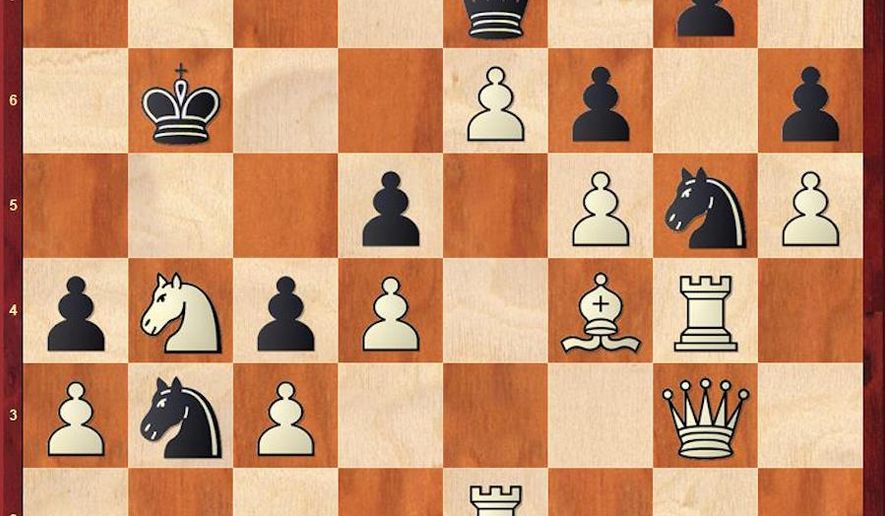Streaking is making a comeback.
No, not the naked romps through public places, though the idea does sound tempting in this age of quarantine. We’re talking competitive marks like Joe DiMaggio’s 56-game hitting streak or Edwin Moses’s nearly 10-year unbeaten streak in the 400-meter hurdles.
World champion Magnus Carlsen, for instance, is on an incredible roll — his last defeat at classic time controls came two years and 120 games ago, when he lost to Azeri GM Shakhriyar Mamedyarov at Biel in July 2018. The Norwegian titleholder has blown through a series of rapid online tournaments this summer, and just went a perfect 10-for-10 in preliminary mini-matches in the Chess24 Legends of Chess event that concludes this week.
Carlsen rates a chapter in veteran California IM Cyrus Lakdawala’s latest book, “In The Zone: The Greatest Winning Streaks in Chess History” (New In Chess, 397 pp., $29.95). The very readable survey highlights 13 of the best runs of skill (and, sometimes, luck) in the history of the game, from Morphy’s rampage through the First American Chess Congress in 1858 to Bobby Fischer’s 11-0 shutout at the 1963-1964 U.S. championship to Anatoly Karpov’s amazing 3½ point win over a world-class field in Linares in 1994.
Latvian world champ Mikhail Tal played a risk-taking, crowd-pleasing brand of chess that ordinarily wouldn’t lend itself to lengthy unbeaten runs. But Lakdawala recounts how the mature Tal mixed astonishing skill with dogged consistency to winning the 1979 FIDE Interzonal in Riga with an undefeated 14-3 scores, including a smashing win over tournament runner-up (and longtime nemesis) Soviet GM Lev Polugaevsky.
In a Symmetrical English, Tal plays a provocative line as Black, allowing his central pawns to be wrecked in exchange for better central control and the ability to plant a knight in the heart of the White camp. After 9. Ng5 Qb6!? (a new move at the time) 10. Qe2?! (too timid; Lakdawala recommends 10. Qf3! h6 [Ne5?! 11. Qh3! Nbc6 12. f4 Nf7 13. Nxe6 is great for White] 11. Nxe6! Qxe6 12. Qxd3) c4 10. b3 h6 12. Nf3 Nc6 13. bxc4 0-0-0, Black has an enormous lead in development for the sacrificed pawn, along with the half-open d- and f-files to play with.
Even two decades are his brief stint as world champ, Tal needs no prompting to attack: 18. Qe3 Rhf8! 19. Rf1 (White’s pathetic hopes of queenside counterplay go down in flames after 19. Nxa7+ Nxa7 20. Qxa7 Qxe4!, attacking and defending) g4 20. Nh4 (Ne1? unfortunately allows 20…Nxc1, winning the piece) Nxf2!, and Tal is in his element.
A trademark sacrificial flurry puts Polugaevsky on the canvas: 21. Ng6 (Rxf2 Rxf2+ 22. Kxf2 [Qxf2 Qxe4+ 23. Kg1 Qxb1] Rf8+, and if 23. Kg1, 23…Qf1 is mate) Rd3! (as Tal himself once famously said, your opponent “can only take one piece at a time!”) 22. Na3 (Qe2 Rxg3+!) Qa4 23. Qe1 (Nxe7+ Nxe7 24. Qc5+ Nc6 25. Rxf2 Qxe4+ again is deadly), and now Black’s tactics lead to mate.
The finale: 23…Rdf3! (offering the exchange) 24. Nxf8 Nd3! (a key zwischenzug) 25. Qd1 (Qe2 Nd4 26. Qd1 Qxd1 27. Rxd1 Rf2+ 28. Kh1 Nf3 29. Nxe6 Rxh2 mate) Qxe4 26. Rxf3 (Kg1 Bd4+) gxf3+ 27. Kf1 Qf5! 28. Kg1 Bd4+, and White resigned ahead of 29. Kh1 (Kf1 Qh3 mate) Nf2+ 30. Kg1 Ne4+ 31. Kh1 (Kf1 Qh3+ 32. Ke1 Bf2 mate) Nxg3+! 32. hxg3 Qh3 mate.
—-
Lakdawala mentions in passing an unlikely holder for a time of the longest unbeaten streak record — veteran Dutch GM Sergei Tiviakov, who went 110 classical games between October 2004 and December 2005 without turning down his king.
The streak came to a crashing halt against GM Konstantin Sakaev at the 2005 World Cup knockout tournament, where the Russian won both games of their mini-match. We pick up the death rattle of Tiviakov’s run in today’s diagram, where Sakaev as White has built up a dominating position and just needs to figure out the breakthrough.
He finds it on 59. Bf3 Na5 60. Qg2 Qb7 61. Rh4 Nb3 62. Rh2! (stopping any Black knight checks on d2) Nh7? (easing White’s task, but equally bleak in the long run was 62…Re7 63. Bxg5 hxg5 64. Kg1 Ka7 65. h6 gxh6 66. Rxh6, and the Black f-pawn must fall because 66…Rf8 allows 67. Bxd5 Qb8 68. Bxa8 Qxa8 69. Nc6+, winning) 63. Re3 Na5 (63…Re7 64. Qg3 Ng5 65. Bd6 Nxf3 66. Rxf3 Ree8 67. Re3 Kb5 68. e7 Rd7 69. Rhe2 Qc8 70. Re6, and the g-pawn is lost) 64. e7!, and Black’s position is collapsing.
After 64…Rxe7 65. Nxd5+ (taking advantage of the overburdened Black queen) Rxd5 66. Bxd5, and Tiviakov resigned as 66…Qa7 67. Rxe7 Qxe7 68. Bxa8 wins major material.
Polugaevsky-Tal, FIDE Interzonal, Riga, Latvia, June 1979
1. Nf3 c5 2. c4 Nf6 3. Nc3 d5 4. cxd5 Nxd5 5. e4 Nb4 6. Bc4 Be6 7. Bxe6 Nd3+ 8. Kf1 fxe6 9. Ng5 Qb6 10. Qe2 c4 11. b3 h6 12. Nf3 Nc6 13. bxc4 O-O-O 14. g3 g5 15. Kg2 Qc5 16. Rb1 Bg7 17. Nb5 Qxc4 18. Qe3 Rhf8 19. Rf1 g4 20. Nh4 Nxf2 21. Ng6 Rd3 22. Na3 Qa4 23. Qe1 Rdf3 24. Nxf8 Nd3 25. Qd1 Qxe4 26. Rxf3 gxf3+ 27. Kf1 Qf5 28. Kg1 Bd4+ White resigns.
• David R. Sands can be reached at 202/636-3178 or by email dsands@washingtontimes.com.
• David R. Sands can be reached at dsands@washingtontimes.com.




Please read our comment policy before commenting.